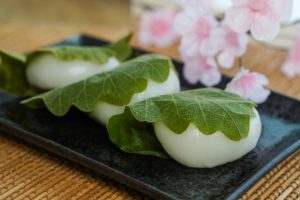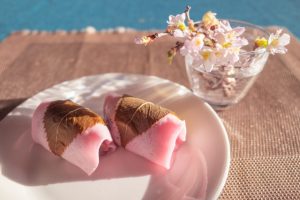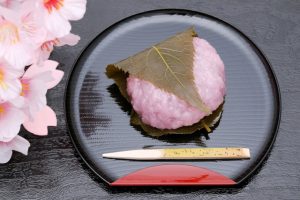Daifuku is pronounced the same as “Daifuku” in Japan, and in Japan, rice cake is called “mochi”. “Mochi” has become well-known, so sometimes it’s referred to as “mochi” even in English, so let’s call it “mochi” here.
For travelers, daifuku and mochi might seem like similar sweets, right? They both have a chewy texture and feel like they belong in the same category. However, to Japanese people, they’re actually a bit different.
Travelers might not be too concerned with the details, but since we’re here, please read on a bit.
The left side of the photo is daifuku (a traditional Japanese sweet called “mame daifuku”). The right side is a Japanese sweet called “kashiwa mochi,” which uses mochi. Do you notice that daifuku looks a bit translucent compared to mochi?
The white part of daifuku is called “mochi,” which is wrapped around it. Mochi is made by mixing powdered glutinous rice with water, sugar, and syrup. On the other hand, mochi is made by pounding steamed glutinous rice. Because of this, mochi is slightly sweet, while mochi is not sweet. The slight sweetness of daifuku comes from this.
There are various types of daifuku, such as plain daifuku, mame daifuku, strawberry daifuku, fruit daifuku, and cream daifuku.
Plain daifuku: Filled only with red bean paste.
Mame daifuku: Red beans are kneaded into the dough, and it’s filled with red bean paste.
Strawberry daifuku: A whole strawberry is inside the dough. It offers a harmony of tartness and sweetness.

Fruit daifuku: Daifuku with fruit inside the dough. It can contain fruits such as kiwi, mandarin orange, etc.

Cream daifuku: It can have not only red bean paste but also a combination of red bean paste and cream, or just cream filling.
On the left side is red bean paste with matcha-flavored cream. On the right side is a daifuku with matcha-flavored dough wrapped around cream filling.

Next is mochi. Two types of mochi commonly enjoyed in Japanese sweets are “kashiwa mochi” and “sakura mochi.”
Kashiwa mochi is mochi filled with sweet red bean paste, wrapped in leaves from the kashiwa (Japanese oak) tree.

The aroma of the kashiwa leaves transfers to the mochi, and when you put it in your mouth, the faint fragrance becomes oddly addictive.
In fact, in Japan, “kashiwa” is considered auspicious. The leaves of the kashiwa tree, because they don’t fall until new shoots appear, symbolize continuity between generations, likening new shoots to children and old leaves to parents, thus representing “perpetuation of the family line” and “prosperity of descendants.” Therefore, kashiwa mochi, wrapped in kashiwa leaves, has become established as a symbol of good luck. However, since kashiwa mochi is consumed regularly in daily life, I don’t think many Japanese people are aware that it’s considered lucky food while eating it.
Sakura mochi is a type of mochi with sweet red bean paste inside a pink-colored mochi, wrapped in salt-preserved cherry blossom leaves.

The beautiful pink color of the mochi is indeed captivating. Unlike the kashiwa leaves of kashiwa mochi, you can actually eat the cherry blossom leaves of sakura mochi. While some Japanese people eat them together with the mochi, others don’t, so there’s no obligation to consume them. However, since the saltiness of the leaves complements the sweetness of the red bean paste, it’s recommended to enjoy them together.
Sakura mochi differs in shape between the Kanto region (Tokyo, Kanagawa, etc.) and the Kansai region (Osaka, Kyoto, etc.). The description you provided is for Kanto-style sakura mochi, which has an elongated oval shape. In Kansai, however, round sakura mochi is the standard.

In Kansai, sakura mochi has a coarse texture, unlike the smooth texture of Kanto-style sakura mochi. However, they both have the same filling of sweet red bean paste wrapped in cherry blossom leaves.
Now, both daifuku and mochi, as explained, are very close to the daily lives of Japanese people and are commonly consumed. Therefore, they are easily accessible to travelers as traditional Japanese sweets that can be purchased at supermarkets and convenience stores nationwide. Supermarkets often offer handmade products and items made in their own factories, showcasing regional uniqueness. How about taking a little break during your travels with these treats?

